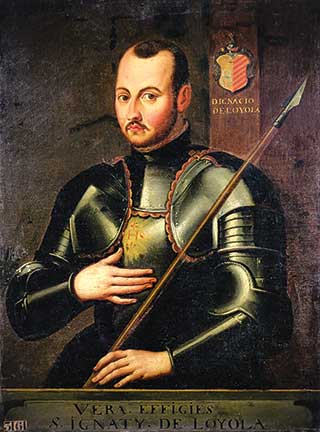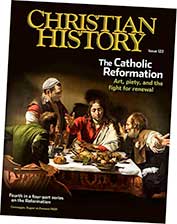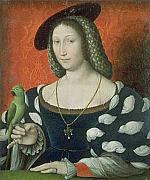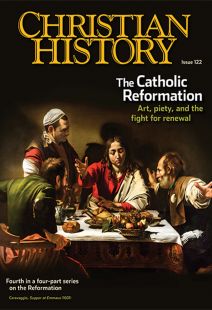Helping souls

[The young Loyola in armor; Wikipedia]
SEVERELY INJURED BY A CANNONBALL that had wounded both his legs, the young Spanish man knew his military career was over. In spite of the doctors’ dire predictions, he had survived surgery (no easy feat in a pre-anesthesia era) and was now learning to walk again.
This young man, of wealthy birth and luxurious tastes, had once longed only for battle and tales of chivalry, but he now had a growing interest in spiritual things; he was beginning to pray and meditate, desiring to follow God. He would make a pilgrimage to Jerusalem, he decided.
His first stop was the monastery of Santa Maria de Montserrat in Catalonia, Spain. There in March 1522, he bowed before an image called the “Black Madonna,” a statue of the Virgin Mary. He left his military cloak and his sword before the image. When he arose it was to become a warrior in a different battle: the battle for the soul.
A different reformation
The young man—Ignatius of Loyola (1491–1556)—and the movement he founded in 1540, the Society of Jesus or the Jesuits, need to be seen as part of a larger move of reform sweeping sixteenth-century Catholicism. Many Catholics had been asking throughout the Middle Ages how they might bind themselves to a more pious way of life, as well as criticizing the monks and priests of their day as comfortable, lazy, hypocritical, and illiterate.
This desire to cast off complacency and comfort, to dive deeply into the Scriptures and the contemplation of God’s grace, to explore a depth of relationship with God that others of their generation manifestly lacked, was the impetus that gave birth to the Protestant Reformation. But it was also the story of the Catholic Reformation.
Well before Luther and Zwingli, reform movements of the medieval period had already charted a similar course. In the late eleventh century, for example, a Benedictine abbot, Robert of Molesme (1028–1111) and several of his monks found their abbey too worldly. They left to build a life where Benedictines would actually follow the Rule of Benedict. The resulting order became known as the Cistercians. (By the seventeenth century, the Cistercians themselves became subject to an even stricter reform, known as the “Trappists” after the Abbey of Notre Dame de la Grande Trappe, the center of the reform.)
The Carthusian Order, founded by Bruno of Cologne (c. 1030–1101) in 1084, also returned to the Rule of Benedict but upped the ante with stricter practices of solitude and silence. (Henry VIII of England would later martyr 18 London Carthusians who refused to agree with his divorce from Catherine of Aragon.)
But now, contributing to the sixteenth century’s reforming spirit, many reacted to their own generation’s culture of rule-bending monks—loudly denounced by Protestants and unflatteringly depicted in woodcuts as well.
For example many Catholic authorities attempted to straighten out already existing religious orders that had grown lax in their disciplines of poverty, chastity, and obedience. This laxity included everything from eating sumptuous food to owning vast amounts of property to slacking on their duties in daily prayer to keeping mistresses to dressing luxuriously (in one abbot’s case, in red silk slippers!).
In light of such abuses, the Council of Trent set out to renew the piety and discipline of religious orders (see “The persistent council,” pp. 19–22, and “A renewed and global faith,” pp. 23–25). Trent first convened in 1545, only a few years after Ignatius founded the Jesuits. In its decree “Concerning Regulars and Nuns,” Trent urged that abbots, abbesses, and other heads of religious orders hold their members accountable to the orders’ original rules and vows. (“Regulars” here refers to those who follow a rule, or regula, within the context of a religious order. They are usually called simply “religious”—used as a noun—as opposed to “secular” clergy who do not take vows and who are employed “out in the world.”)
This renewed commitment to piety and order expressed at Trent also included a return to the controversial practice of “enclosure” for nuns. This meant that female religious were not to leave their convents, nor were they to permit visitors from outside.
While some orders embraced this policy—the Poor Clares had already incorporated it into their rule—others resisted, finding it contrary to their long-established practices of running schools for the children of their cities, or otherwise ministering in public and visible ways.
The nuns of the Pütrich Convent in Munich even carried out a covert operation to acquire the bones of a Christian martyr, Saint Dorothea. With the bones installed in the convent, they now had an excuse to invite the community into their convent church, all while using a reason that had been officially sanctioned by Trent (the public veneration of saints and relics).
Let’s start over
Others in the sixteenth century sought to answer the question of how to live more holy lives for Christ by establishing new religious orders. The Theatine Order, founded and given papal approval in 1524, aimed first to renew the devotional lives of priests who committed to the Theatine way of life. Then through these renewed priests, the Theatines wanted to call Christians generally back to a life of holiness (see “Remaking the world,” pp. 40–43).
The Theatines vowed to own no property, though they allowed the income from ecclesiastical posts to be shared in common among members. When supplies were lean, they were not permitted to beg, though they were allowed to accept alms freely given.
Members were enjoined to imitate Christ; that is, to meditate on Christ’s passion and observe the virtues Jesus displayed in his suffering, such as obedience, self-mastery, and self-denial. That force animated the words of Gian Pietro Carafa (later Pope Paul IV) in the original rule of the Theatine Order. There he stated that members
will be taught daily through experience the Lord’s word and its power as he says: “Whoever wants to be my disciple must deny themselves and take up their cross and follow me” (Matt. 16:24).
This brings us back to Ignatius of Loyola, perhaps the greatest example of the reawakening of piety and contemplation of the life of Christ in sixteenth-century Catholicism. Born in the Basque region of northern Spain, Iñigo Lopez de Oñaz y Loyola (Ignatius is the Latin version of his name) was the youngest child of the noble Loyola family. His mother died when he was young, and his father when he was 16.
Despite his personal tragedies, the young man enjoyed all the privileges and recreations of the aristocracy, from nights on the town to the courting of beautiful ladies. One biographer later described him as a “fancy dresser, an expert dancer, a womanizer, sensitive to insult, and a rough punkish swordsman who used his privileged status to escape prosecution for violent crimes committed with his priest brother at carnival time.”
Ignatius showed little serious religious inclination until the catastrophic events of the Battle of Pamplona in 1521. He was defending a fortress from the French when a cannonball injured his legs—and the rest of his career as a soldier.
He ended up with one leg shorter than the other and asked the doctors to perform surgery to bring them closer to the same length, since he now wanted to become a courtier and diplomat. As a result of the surgery he spent months in recovery at the Loyola castle, with only two books to distract him from his world of pain: The Golden Legend (c. 1260) and Ludolph of Saxony’s The Life of Christ (1374). He asked for books of chivalry, but there none were available.
“An embassy of tears and good works”
The first of the books given to Ignatius was a best-selling collection of stories of the lives of the saints. The second was a commentary on Jesus’ life, a harmony of the Gospels that drew on the writings of the church fathers. Ludolph included there this prayer:
Lord Jesus Christ, splendor of the Father’s glory, send down upon me the intense fervor of the Holy Spirit to enkindle, increase, and perfect in me the love of God and my neighbor. Sever me from carnal affections and sensual pleasures.
Impart the grace to love thee above all things; with thy help to exercise prudence in all my duties; never to rely upon my own strength or merits; but ever and anon to send to thee an embassy of tears and good works; to seek and to bring back, peace from thee.
And help me to renounce all in spirit and actually forsake all to be thy true disciple. Amen.
Herbs and austerities
Together these books changed Ignatius’s life. In contrast to the dread and depression he experienced when he thought of returning to his old way of life, the lives of Christ and the saints filled him with a sense of “consolation.” In his autobiography dictated to one of his followers he said, speaking of himself in the third person:
When he thought of worldly things it gave him great pleasure, but afterward he found himself dry and sad. But when he thought of journeying to Jerusalem, and of living only on herbs, and practising austerities, he found pleasure not only while thinking of them, but also when he had ceased.
Ignatius decided that he wanted to spend the rest of his life ministering to others, or as he called it, “helping souls.” Upon his recovery he spent time in retreat and prayer and pilgrimage.
Order Christian History #122: The Catholic Reformation in print.
Subscribe now to get future print issues in your mailbox (donation requested but not required).
In this period he crafted the guides to devotion known as the Spiritual Exercises (eventually published in 1541). Even before he brought together the Society of Jesus, whose members would work through the Exercises systematically while on retreat, Ignatius led individuals through them, aiming to foster the same religious conversion and “discernment of spirits” he had experienced.
Ignatius decided that he would need more theological education and formation himself if he was going to dedicate his life to “helping souls,” and he enrolled first at the University of Alcalá and later at the University of Paris to get it. In Paris he connected with other students who would form the original core of the Jesuits, spending time with them in prayer and leading them through the Exercises.
Momentous meeting
On August 15, 1534, Peter Faber (1506–1546) and Francis Xavier (1506–1552) met with Ignatius and four other students in a crypt beneath the Church of Saint Denis in Montmartre and vowed to obey the pope, practice poverty and chastity, and make a missionary voyage to the Holy Land. Upon graduation the group’s first ambition was to put their Holy Land plan into practice.
Finding delays at every turn, they spent their days in ministry in Venice instead, and then in Rome, where, through prayer and discussion and discernment, they decided to seek papal approval of their new order. In 1540 they secured this approval from Pope Paul III, swearing to obey any call to be sent anywhere in the world to preach the Gospel and care for the sick.
This willingness to travel would see the early Jesuits establishing missions as far afield as South America, India, China, Japan, and the Philippines. Comparative flexibility in the order’s rules, the lack of a required religious habit, and a special emphasis in the Spiritual Exercises on finding God in all things frequently led the Jesuits to adapt to their diverse contexts, a practice often referred to today as “inculturation.” (The famed adaptability of the Jesuits makes them the obvious choice to undertake a fictional mission to outer space in Mary Doria Russell’s 1996 novel The Sparrow.)
Jesuit missionary Matteo Ricci (1552–1610), for example, famously adopted traditional Mandarin dress in China. And when Jesuit Frances Xavier traveled to Japan in 1549, realizing that his poverty was having the opposite of its intended effect, he adopted a different approach (see picture, p. 23).
Xavier arranged to make a presentation to a Portuguese prince while dressed in fine vestments and attended by servants bearing a picture of the Virgin Mary and velvet slippers. These fine gifts were then presented by the servants, not to the prince, but to Xavier—to improve his reputation among his Japanese onlookers.
Putting aside private judgment
Despite this flexibility, however, members of the Society of Jesus maintained as a core principle their vow of obedience to the pope, also expressed in Ignatius’s encouragement to his followers in the Spiritual Exercises to “think with the Church.” Among the rules for this practice were not only “putting aside all private judgment,” but even, famously, being prepared to “believe that the white that I see is black, if the hierarchical Church so defines it.”
Such ready obedience tended to spook Protestants, who sometimes saw the renewed vigor of Catholic pursuit of holiness as a new version of works-based righteousness. But to sixteenth-century Catholics, reeling from the devastating divisions wrought within the Western church, the surest way to heal seemed to be to instill in priests and laypeople “the desire for a more devout life.” Or in other words, to teach them to pray to God with Ignatius, “Give me Thy love and Thy grace, for this is enough for me.” CH
This article is from Christian History magazine #122 The Catholic Reformation. Read it in context here!
Christian History’s 2015&ndash2017 four-part Reformation series is available as a four-pack. This set includes issue #115 Luther Leads the Way; issue #118 The People’s Reformation; issue #120 Calvin, Councils, and Confessions; and issue#122 The Catholic Reformation. Get your set today. These also make good gifts.
By Katie M. Benjamin
[Christian History originally published this article in Christian History Issue #122 in 2017]
Katie M. Benjamin is a Th.D. candidate at Duke University working in Reformation history and theology.Next articles
The Council of Trent speaks
Twenty-fifth Session (December 3–4, 1563), “Concerning Regulars and Nuns”
Council of TrentIgnatius of Loyola speaks
“Contemplation to Attain Divine Love,” The Spiritual Exercises (1541)
Ignatius of LoyolaThe road not taken
Evangelical Catholics worked for reform without leaving their mother church
Edwin Woodruff TaitSupport us
Christian History Institute (CHI) is a non-profit Pennsylvania corporation founded in 1982. Your donations support the continuation of this ministry
Donate






